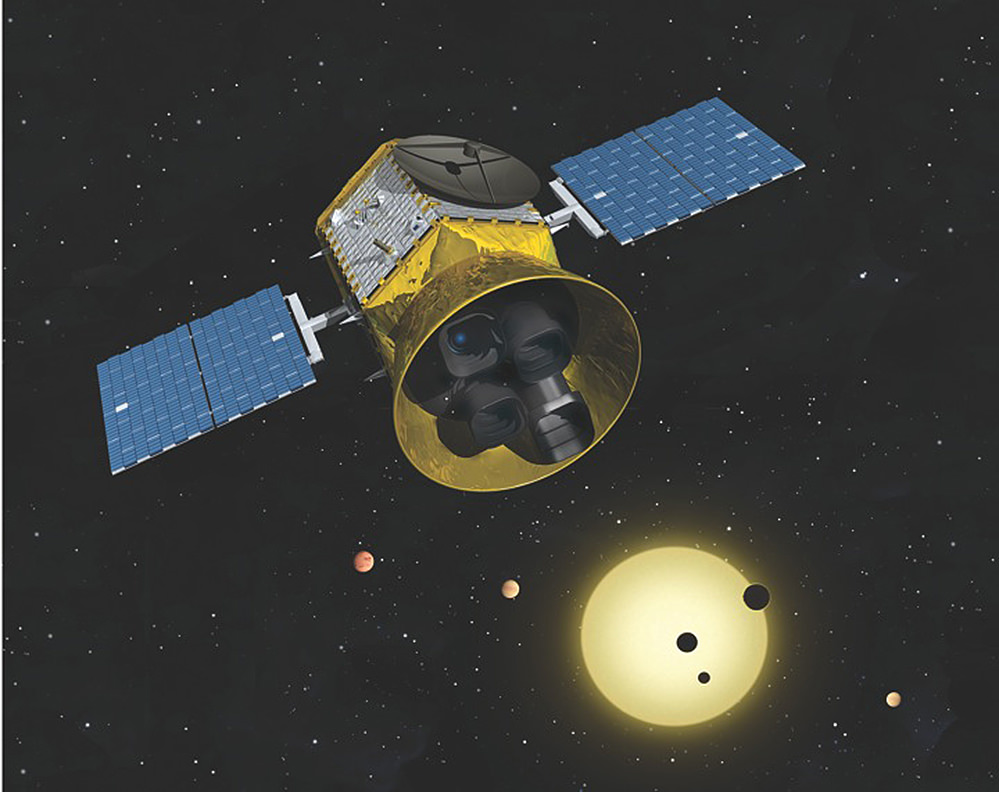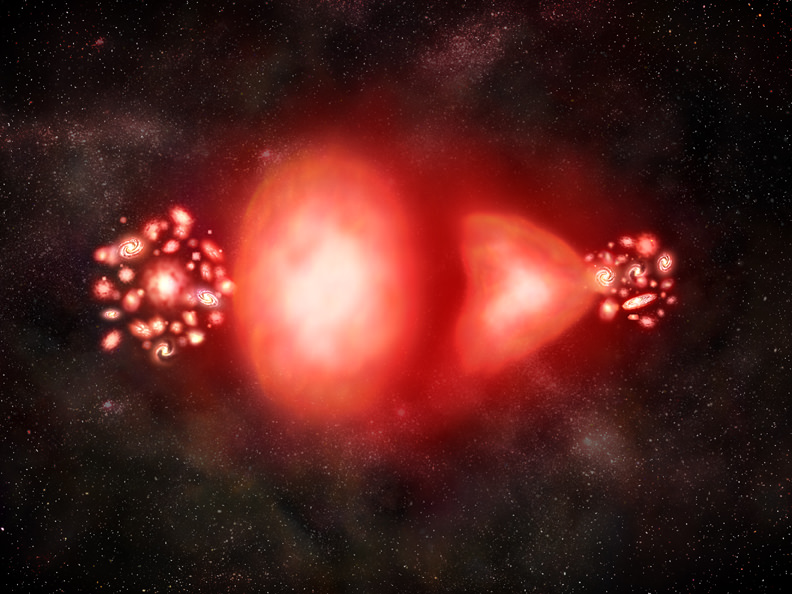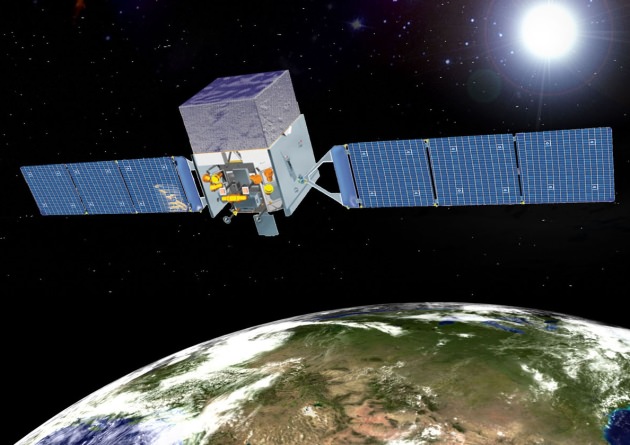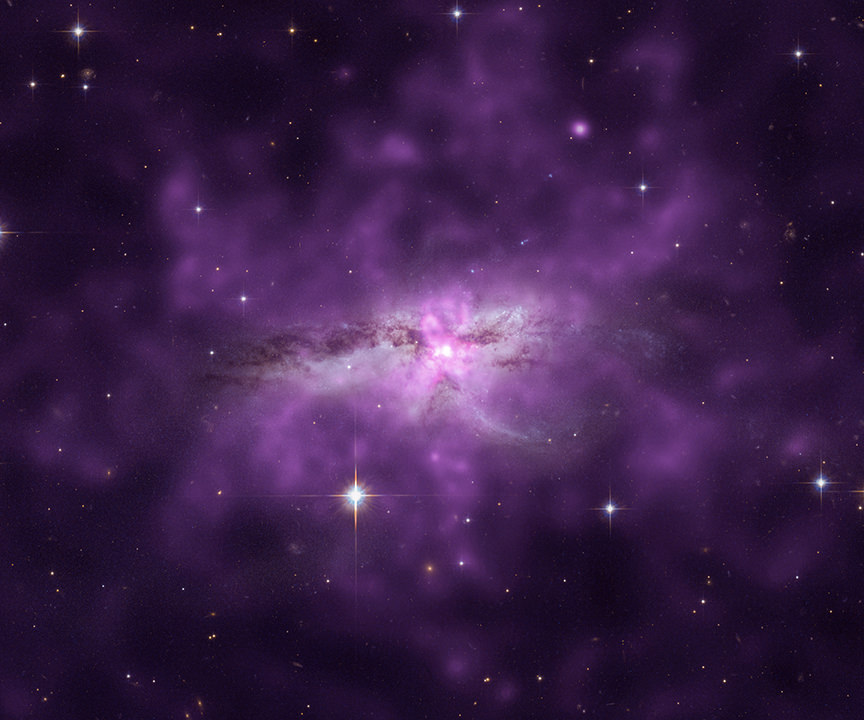Here’s the latest update on what’s up in the night sky from Jane Houston Jones at the Jet Propulsion Laboratory. The Moon will be your guide on how to spot the spring constellations and other popular astronomical sights this month including nebulae, a galaxy trio and the site of a recent planetary discovery.
Watch Live Hangout: TESS and the Search for Exoplanets
Last month, NASA announced plans to launch the Transiting Exoplanet Survey Satellite (TESS) in 2017. This is a satellite that will perform an all-sky survey to discover transiting exoplanets in orbit around the brightest stars in the Sun’s neighborhood. “TESS will carry out the first space-borne all-sky transit survey, covering 400 times as much sky as any previous mission,” said George Ricker, the mission’s principal investigator. “It will identify thousands of new planets in the solar neighborhood, with a special focus on planets comparable in size to the Earth.”
Read more about the TESS mission here.
Today, Wednesday May 1, at 19:00 UTC (12:00 p.m. PDT, 3:00 pm EDT) you can take part in a live Google+ Hangout, and have your questions answered about TESS and the search for exoplanets with three leading members of NASA’s TESS mission:
George Ricker is principal investigator of the TESS mission and a senior research scientist at the MIT Kavli Institute for Astrophysics and Space Research (MKI) in Cambridge, Mass.
Sara Seager is a professor of planetary science and physics at MKI and a member of the TESS team. Seager’s research focuses on computer models of exoplanet atmospheres, interiors and biosignatures.
Joshua Winn is an associate professor of physics at MKI and deputy science director for the TESS mission. Winn is interested in the properties of planets around other stars, how planets form and evolve, and whether there are habitable planets beyond Earth.
Watch in the viewer above, or at the Kavli Foundation website.
Questions can be submitted ahead of and during this special event via Twitter using the hashtag #KavliAstro and by email to [email protected].
Will Antimatter Obey Gravity’s Pull?
What goes up must always come down, right? Well, the European Laboratory for Particle Physics (CERN) wants to test if that principle applies to antimatter.
Antimatter, most simply speaking, is a mirror image of matter. The concept behind it is that the particles that make up matter have an opposite counterpart, antiparticles. For example, if you consider that electrons are negatively charged, an antielectron would be positively charged.
This sounds like science fiction, but as NASA says, it is “real stuff.” In past experiments, CERN’s particle accelerator has created antiprotons, positrons and even antihydrogen. Properly harnessed, antimatter could be used for applications ranging from rocketry to medicine, NASA added. But we’ll need to figure out its nature first.
The Curious Channel 37 — Must-see TV For Radio Astronomy
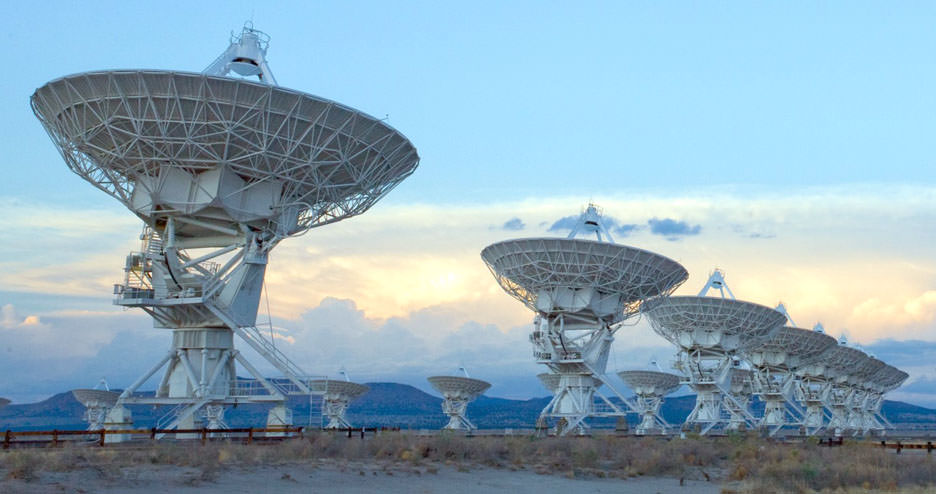
Thanks to Channel 37, radio astronomers keep tabs on everything from the Sun to pulsars to the lonely spaces between the stars. This particular frequency, squarely in the middle of the UHF TV broadcast band, has been reserved for radio astronomy since 1963, when astronomers successfully lobbied the FCC to keep it TV-free.
Back then UHF TV stations were few and far between. Now there are hundreds, and I’m sure a few would love to soak up that last sliver of spectrum. Sorry Charley, the moratorium is still in effect to this day. Not only that, but it’s observed in most countries across the world.

So what’s so important about Channel 37? Well, it’s smack in the middle of two other important bands already allocated to radio astronomy – 410 Megahertz (MHz) and 1.4 Gigahertz (Gz). Without it, radio astronomers would lose a key window in an otherwise continuous radio view of the sky. Imagine a 3-panel bay window with the middle pane painted black. Who wants THAT?
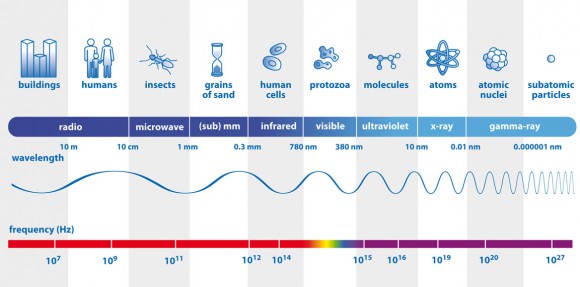
Channel 37 occupies a band spanning from 608-614 MHz. A word about Hertz. Radio waves are a form of light just like the colors we see in the rainbow or the X-rays doctors use to probe our bones. Only difference is, our eyes aren’t sensitive to them. But we can build instruments like X-ray machines and radio telescopes to “see” them for us.
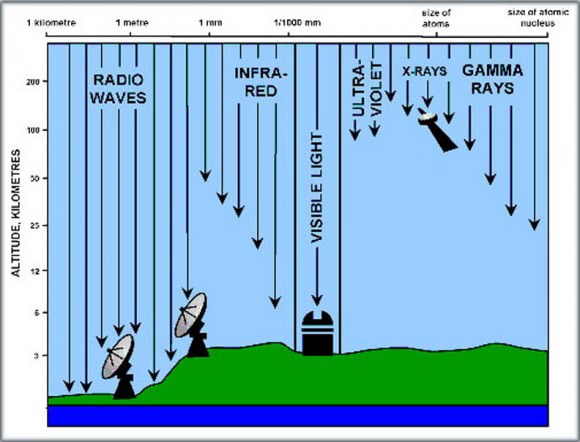
Every color of light has a characteristic wavelength and frequency. Wavelength is the distance between successive crests in a light wave which you can visualize as a wave moving across a pond. Waves of visible light range from one-millionth to one-billionth of a meter, comparable to the size of a virus or DNA molecule.
X-rays crests are jammed together even more tightly – one X-ray is only as big as an small atom. Radio waves fill out the opposite end of the spectrum with wavelengths ranging from baseball-sized to more than 600 miles (1000 km) long.
The frequency of a light wave is measured by how many crests pass a given point over a given time. If only one crest passes that point every second, the light beam has a frequency of 1 cycle per second or 1 Hertz. Blue light has a wavelength of 462 billionths of a meter and frequency of 645 trillion Hertz (645 Terahertz).
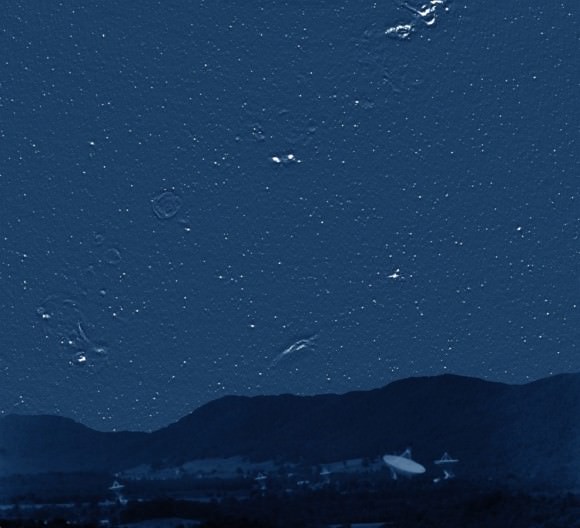
The higher the frequency, the greater the energy the light carries. X-rays have frequencies starting around 30 quadrillion Hertz (30 petahertz or 30 PHz), enough juice to damage body cells if you get too much exposure. Even ultraviolet light has power to burn skin as many of us who’ve spent time outdoors in summer without sunscreen are aware.
Radio waves are the gentle giants of the electromagnetic spectrum. Their enormous wavelengths mean low frequencies. Channel 37 radio waves have more modest frequencies of around 600 million Hertz (MHz), while the longest radio waves deliver crests almost twice the width of Lake Superior at a rate of 3 to 300 Hertz.
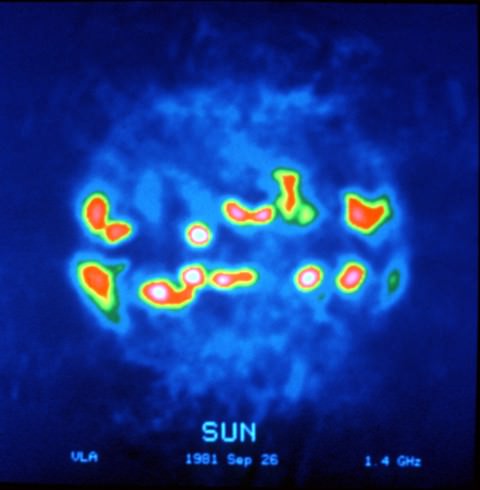
If Channel 37 were ever lost to TV, the gap would mean a loss of information about the distribution of cosmic rays in the Milky Way galaxy and rapidly rotating stars called pulsars created in the wake of supernovae. Closer to home, observations in the 608-614 MHz band allow astronomers track bursts of radio energy produced by particles blasted out by solar flares traveling through the sun’s outer atmosphere. Some of these can have powerful effects on Earth. No wonder astronomers want to keep this slice of the electromagnetic spectrum quiet. For more details on how useful this sliver is to radio astronomy, click HERE.
Just as optical astronomers seek the darkest sites for their telescopes to probe the most remote corners of the universe, so too does radio astronomy need slices of silence to listen to the faintest whispers of the cosmos.
The Sun Burps Out a Gigantic Rolling Wave
Just in time for May Day, the Sun blasted out a coronal mass ejection (CME) from just around the limb earlier today, May 1, 2013. In a gigantic rolling wave, this CME shot out about a billion tons of particles into space, traveling at over a million miles per hour. This CME is not headed toward Earth. The video, taken in extreme ultraviolet light by NASA’s Solar Dynamics Observatory (SDO), covers about two and a half hours of elapsed time.
Camilla, the rubber chicken mascot for the SDO, said via YouTube that getting this side view shows the power and force behind these solar flares and coronal mass ejections.
This image shows three views of the CME from three different instruments. Left is the SDO image, taken at 02:40 UT. Center is from the SOHO spacecraft, looking through their coronograph instrument. The “mushroom” cloud of plasma leaving the Sun is visible. On the right is the LASCO C2 (red) and C3 (blue) instruments on SOHO, which use a disk to block out the Sun. Visible are the solid occulter disk, used to create a false eclipse; the “pylon”, which is an arm that holds the occulter disk in place; a representation of the Sun in the form of a white disk drawn on the occulter during our image processing and then you can see background stars and the cloud of plasma leaving the Sun.
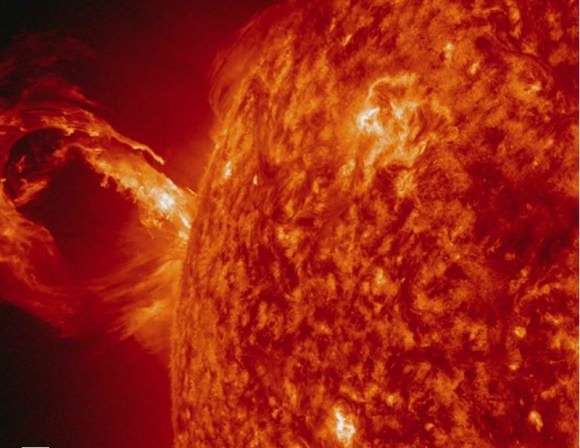
How the Fermi Spacecraft Almost Got Taken Out by a Relic of the Cold War
As a space telescope scientist or satellite operator, the last thing you want to hear is that your expensive and possibly one-of-a kind — maybe irreplaceable — spacecraft is in danger of colliding with a piece of space junk. On March 29, 2012, scientists from the Fermi Gamma-ray Space Telescope were notified that their spacecraft was at risk from a collision. And the object heading towards the Fermi spacecraft at a relative speed of 44,000 km/h (27,000 mph) wasn’t just a fleck of paint or tiny bolt.
Fermi was facing a possible direct hit by a 1,400 kg (3,100-pound) defunct Russian spy satellite dating back to the Cold War, named Cosmos 1805. If the two satellites met in orbit, the collision would release as much energy as two and a half tons of high explosives, destroying both spacecraft and creating more pieces of space junk in the process.
But this story has a happy ending, with the Fermi telescope still operating and continuing its mission to map the highest-energy light in the universe, all thanks to a little orbital traffic control.
You can watch the video here for the complete story, or read more at the Fermi website about how the Fermi Space Telescope dodged a speeding bullet.
NGC 6240: Gigantic Hot Gas Cloud Sheaths Colliding Galaxies
Looking almost like a cosmic hyacinth, this image is anything but a cool, Spring flower… it’s a portrait of an enormous gas cloud radiating at more than seven million degrees Kelvin and enveloping two merging spiral galaxies. This combined image glows in purple from the Chandra X-ray information and is embellished with optical sets from the Hubble Space Telescope. It flows across 300,000 light years of space and contains the mass of ten billion Suns. Where did it come from? Researchers theorize it was caused by a rush of star formation which may have lasted as long as 200 million years.
What we’re looking at is known in astronomical terms as a “halo” – a glorious crown which is located in a galactic system cataloged as NGC 6240. This is the site of an interacting set of of spiral galaxies which have a close resemblance to our own Milky Way – each with a supermassive black hole for a heart. It is surmised the black holes are headed towards each other and may one day combine to create an even more incredible black hole.
However, that’s not all this image reveals. Not only is this pair of galaxies combining, but the very act of their mating has caused the collective gases to be “violently stirred up”. The action has caused an eruption of starbirth which may have stretched across a period of at least 200 million years. This wasn’t a quiet event… During that time, the most massive of the stars fled the stellar nursery, evolving at a rapid pace and blowing out as supernovae events. According to the news release, the astronomers who studied this system argue that the rapid pace of the supernovae may have expelled copious quantities of significant elements such as oxygen, neon, magnesium and silicon into the gaseous envelope created by the galactic interaction. Their findings show this enriched gas may have expanded into and combined with the already present cooler gas.
Now, enter a long time frame. While there was an extensive era of star formation, there may have been more dramatic, shorter bursts of stellar creation. “For example, the most recent burst of star formation lasted for about five million years and occurred about 20 million years ago in Earth’s time frame.” say the paper’s authors. However, they are also quick to point out that the quick thrusts of star formation may not have been the sole producer of the hot gases.
Perhaps one day these two interactive spiral galaxies will finish their performance… ending up as rich, young elliptical galaxy. It’s an act which will take millions of years to complete. Will the gas hang around – or will it be lost in space? No matter what the final answer is, the image gives us a first-hand opportunity to observe an event which dominated the early Universe. It was a time “when galaxies were much closer together and merged more often.”
Original Story Source: Chandra X-Ray Observatory News Release.
An Awesome Look at Enceladus, the Jet-Powered Moon
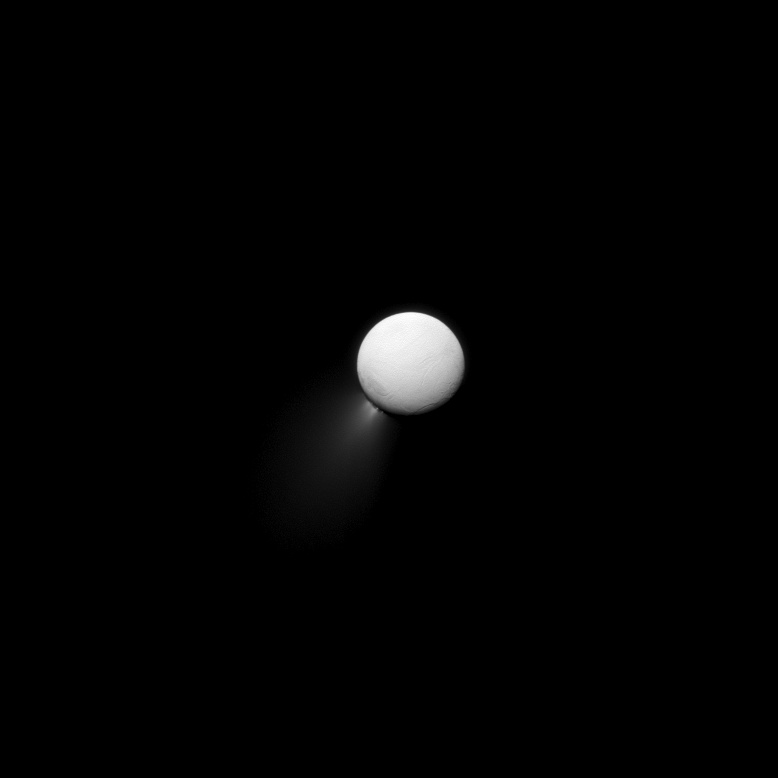
According to planetary scientist and Cassini imaging team leader Carolyn Porco, about 98 geyser jets of all sizes near Enceladus’s south pole are spraying water vapor, icy particles, and organic compounds out into space. The spray from those geysers are evident in this new image from Cassini, showing a big, beautiful plume, illuminated by light reflected off of Saturn. Look closely to see that the plume is as large as the moon itself.
Cassini first discovered the jets of water ice particles in 2005, and since then scientists have been trying to learn more about how they behave, what they are made of and – most importantly – where they are coming from. The working theory is that Enceladus has a liquid subsurface ocean, and pressure from the rock and ice layers above combined with heat from within force the water up through surface cracks near the moon’s south pole. When this water reaches the surface it instantly freezes, sending plumes of ice particles hundreds of miles into space.
Read more: Enceladus’ Jets Reach All the Way to its Sea
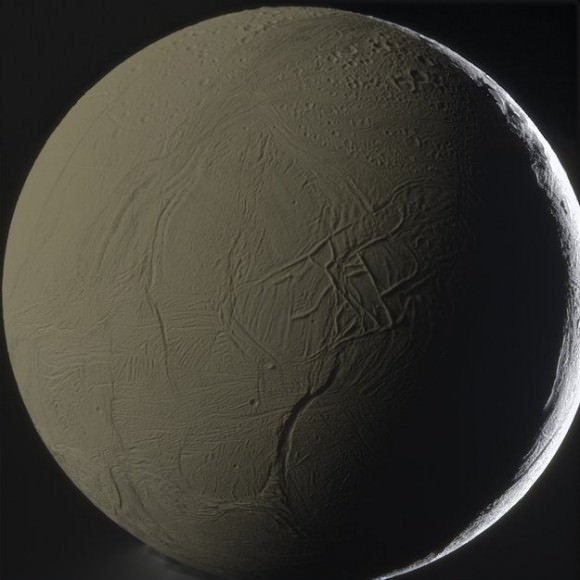
Cassini has flown through the spray several times now, and instruments have detected that aside from water and organic material, there is salt in the icy particles. The salinity is the same as that of Earth’s oceans.
Enceladus is just 504 kilometers (313 miles) across, but it potentially could be one of the best spots in the solar system for finding life.
The top image was taken on January 18, 2013. This view looks toward the Saturn-facing side of Enceladus, and was taken when Cassini was approximately 483,000 miles (777,000 kilometers) from Enceladus. Image scale is 3 miles (5 kilometers) per pixel.
The second, face-on, color view of Enceladus was taken by the Cassini spacecraft on January 31 2011, from a distance of 81,000 km, and processed by amateur astronomer Gordan Ugarkovic.
Space Robotics Dominate New $5 Bill in Canada

In a world first, Canada’s Chris Hadfield unveiled a new money note — while in space.
Hadfield spun a fiver before the camera Tuesday as part of a ceremony to announce new $5 and $10 bills that will be distributed in Canada this year. The $5 bill will feature two pieces of Canadian technology that helped build the station: Canadarm2, which is a mobile robotic arm, and the hand-like Dextre.
The bill also shows an unidentified astronaut. That said, the choice to use Hadfield in the press conference was likely not a coincidence: Hadfield assisted with Canadarm2’s installation in 2001 when he became the first Canadian to walk in space.
“These bills will remind Canadians, every time they buy a sandwich and a coffee and a donut, what we are capable of achieving,” said Hadfield, who is in command of Expedition 35 on the International Space Station. His comments were carried on a webcast from the Bank of Canada.
The money note travelled with Hadfield in his Soyuz when he rocketed to the station in December, the Canadian Space Agency told Universe Today.
The polymer notes are intended to be more secure than the last generation of bills issued in Canada. Polymer $20, $50 and $100 bills are already available, but the smaller currencies won’t hit consumer pocketbooks until November.
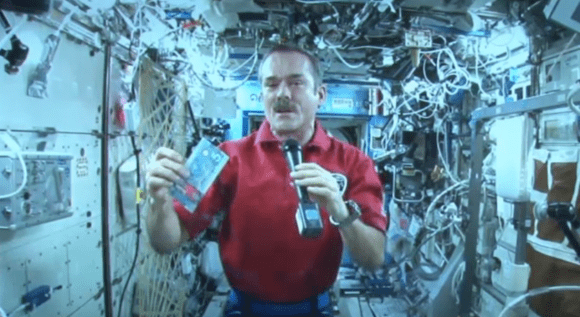
“Featuring a sophisticated combination of transparency and holography, this is the most secure bank note series ever issued by the Bank of Canada. The polymer series is more economical, lasting at least two and half times longer than cotton-based paper bank notes, and will be recycled in Canada,” the Bank of Canada stated in a press release.
As with the past $5 bill, the opposite face of the new bill shows a drawing of past prime minister Wilfrid Laurier. Also shown at the ceremony: the $10 bill, with a Via Canada train on one side and John A. Macdonald, the first Canadian prime minister, on the other.
Both Jim Flaherty, Canada’s minister of finance, and Bank of Canada governor Mark Carney wore Expedition 35 pins at the press conference.
“I hope that’s not London calling,” Flaherty quipped to laughing reporters when NASA’s Mission Control phoned in with Hadfield on the line.
Hadfield is no stranger to space-themed currency. In 2006, the Royal Mint of Canada released two coins featuring him and Canadarm2. Hadfield and several other Canadian astronauts were also put on to Canadian stamps in 2003.
You can check out the full set of polymer bills on this Flickr series uploaded by the Bank of Canada.
Giveaway: Pocket Universe App for Your iOS Device
The name says it all – Pocket Universe answers every question you have and never knew you had about the great beyond – astronomically speaking. Pocket Universe also has a feature that speaks to the trivial in me – the need to fill my brain with interesting factoids that I can regale my friends with at parties.
Universe Today and Craic Design are giving away 10 free copies of Pocket Universe to our readers.
If you don’t want to wait for the win; you can purchase this app through the iTunes Store.
This giveaway will run for a week starting today, so get your entries in! How?
In order to be entered into the giveaway drawing, just put your email address into the box at the bottom of this post (where it says “Enter the Giveaway”) before Tuesday, May 7, 2013. We’ll send you a confirmation email, so you’ll need to click that to be entered into the drawing.
Here are some words from John Kennedy, developer of Pocket Universe: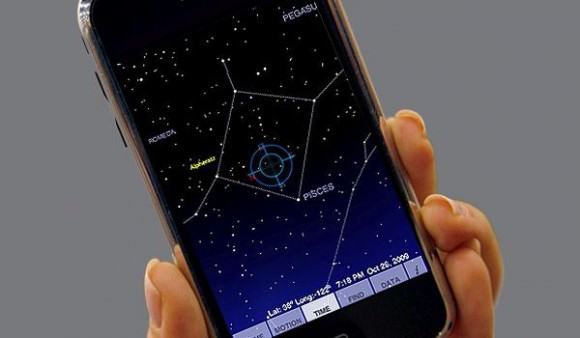
Pocket Universe is one of those apps that re-affirms your belief in modern technology. Take it outside on a dark, cloudless night, hold it up at the sky, and you’ll get a real-time 3D rendered view of the heavens – complete with star and planet names, constellation images, as well as bright satellites, comets and more. If you ever wanted to know what it was you were looking at, this is the app for you. To help with new stargazers, there is also information on what you should be looking out for every month, and a list of interesting things visible on that very night. The app will also pop-up reminders when something interesting is happen – a meteor shower perhaps, or a flypast of the International Space Station – so you don’t miss out.

